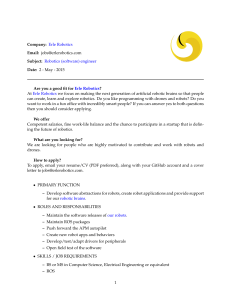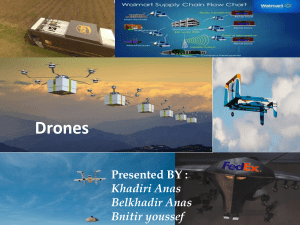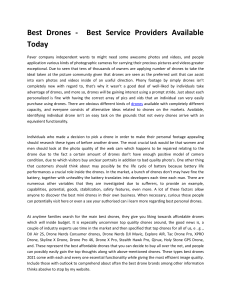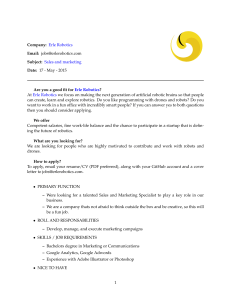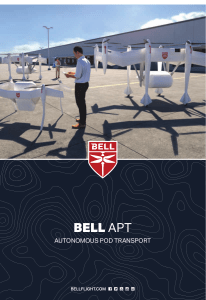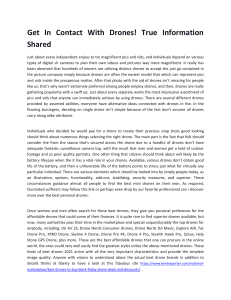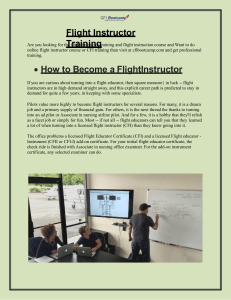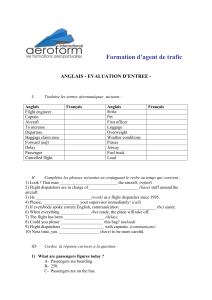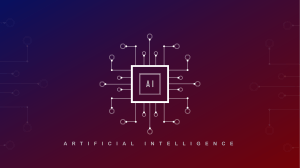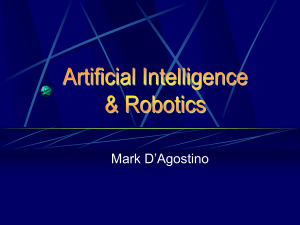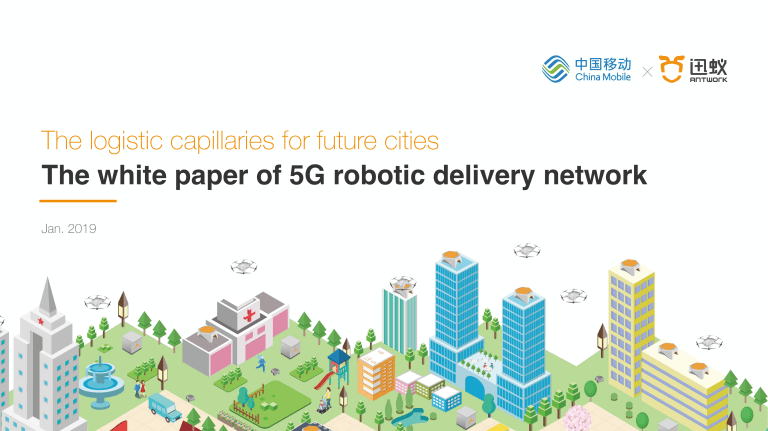
The logistic capillaries for future cities The white paper of 5G robotic delivery network Jan. 2019 A D N E T 1 a The 5G robotic delivery network is the solution for the future cities. With the rapid development of e-commerce, take-out food business, new retail, the demand of urban delivery services in urban areas has been increasing a lot. Meanwhile the disappearance of the demographic dividend has led to a significant shortage of delivery labors. Fast, safe, zero-emission and human labor-independent robots will become an indispensable infrastructure for urban logistics in the future. REPORT SUMMRIES 2 ADNET+5G is an efficient form of robotic delivery network. The ADNET+5G system integrates in drones, unmanned vehicles, unmanned hub stations and unmanned charging depots, and also through the algorithm enables seamless collaboration between robots, so as to make full use of speed advantage of aerial delivery by the drones and the user-friendly interaction of the unmanned vehicles. At the same time, unmanned hub stations and unmanned charging depots help to realize full automation of the whole network in terms of the material cycle and energy cycle. In addition, the upper limit of manpower delivery system will be restricted seriously by labor supply during the process of increasing delivery demand. The disappearance of the demographic dividend is driving up labor costs gradually, but the cost of robot delivery will continue to decrease with the expansion of manufacturing scale. At present, the intersection of the two has emerged, and with the upgrading of technology, the advantages of robots will be prominent increasingly in the future. 3 Safety is a core premise of large-scale operation of robotic delivery network. From design, development, testing to operation of ADNET, safety is always the first priority, which ensure the safety of flight as the primary focus of the system. The safety of the system is guaranteed by the subsystem redundancy, the complete fail-safe mechanism, the large-scale emergency strategies and the equipment of the certified security personnel. Finally, the security of the system has been verified fully by running tests in a real environment with multiple scenes for a long time.. 1 A D N E T a 01 Delivery requirements and solutions for the future cities 2 A D N E T a The consensus is that the industry needs to change “A billion packages a day will take no more than eight years, it could be done in six or seven years.” — Jack Ma “Finding enough labor for the logistics industry could become extremely difficult or even impossible.” — DHL “Get ready for a world where autonomous vehicles deliver 80 percent of parcels.“ — McKinsey&Co 3 A D N E T a Increasing demands widen the labor supply gap The growth rate of the courier express delivery industry has maintained above 25% annually over the past few years, and the total volume of courier express delivery in 2018 has exceeded 50 billion. Meanwhile, the instant delivery of inner-city delivery has been growing faster. The annual instant delivery volume has exceeded 10 billion in 2018, which is 10 times of the volume in 2013. On the other hand, the working-age population in our country is declining year by year. The contradiction between supply and demand of logistics delivery industry is prominent increasingly. Beurea 4 A D N E T a Consumers need higher quality delivery service 1 The requirement for delivery speed is getting higher. 2 Shopping is getting more random. 3 More goods need to be delivered instantly. 4 Goods get closer to consumers. 5 Faster delivery response is expected. 6 Safer, more orderly traffic is needed in urban areas. 5 A D N E T a Problems in traditional delivery service 1 Unstable quality of service 2 Long delivery time 3 Affected by weather 4 Limited night delivery delivery 5 Increased burden of public transportation 6 Intense labor and difficult management 6 A D N E T a Industry giants poured into unmanned delivery Amazon Google UPS DHL Swiss post JD.COM China Post Cainiao Suning ZTO Express 7 A D N E T a The robotic delivery network is the optimal choice Fast 2 Safe Zero-emission Independent of manpower No need for public roads 24-hour service 8 A D N E T a 02 ADNET turns robotic network concept into reality 9 A D N E T a ADNET Introduction ADNET= Autonomous Delivery Network By building a robotic delivery network covering the whole city, ADNET can meet the instant delivery needs of small and medium-sized items in the same city with the highest efficiency. 2 With integration of high moving efficiency drones, user-friendly unmanned vehicles, largescale automatic scheduling algorithm, hub stations, and charging depots, the purely electric driven ADNET can realize fully autonomous operation. Thus ADNET meets the future cities’ logistic requirements of high speed, low cost, environmental-friendliness and all-time service response. 10 A D N E T a Maximized values of connecting According to different types of urban delivery needs, ADNET can build a robots delivery network at commercial district scale or city scale. Moreover, the robotic delivery networks of multiple commercial districts in the same city can be connected to each other, and form a network eventually covering the whole city, connecting every consumer, every business and every Medical needs public service provider in the city. City scale ADNET can provide complete innercity instant delivery service, which can cover all kinds of demands such as Vegetables City express medical emergency, high-timeliness delivery and C2C delivery, and shorten the Medical needs Fruit remium food time span of connection between any two points in the city to less than 45 minutes. Cake The delivery network of the commercial district scale can cover a range of about Food 5km in diameter, and also can connect the surrounding restaurants, supermarkets and pharmacies for the consumers within the service range to deliver the goods in an average time of 10 minutes for take-out and daily life. 11 A D N E T a Algorithms highly integrated with SW and HW Software algorithm Smart hardware Air traffic management Drones The self-driving system Unmanned vehicles Intelligent planning and scheduling Unmanned hub stations Unmanned charging depots 12 A D N E T a Intelligent delivery robots Drone RA3 Unmanned Vehicle RG1 Maximum loading 6kg Maximum miles 25km Wind resistance Level 6 Flying speed 60KM/h Rain and snow proof Maximum loading 10kg Maximum miles 20km Driving speed 10KM/h Indoor / outdoor operation 13 A D N E T a Automatic infrastructure Unmanned Hub Station RH1 Unmanned charging depot RE1 Charging ports for drones and unmanned vehicles Drone apron Goods transit temporary storage 1C high power charging Unmanned car garage The drone lifts the platform Communication positioning aid Contact charging Support for human-computer interaction 14 A D N E T a The self-driving function of the delivery robots The drones and unmanned vehicles in ADNET are all delivery robots with L4 self-driving ability. Perception Decision-making Learning The robots are equipped with a The robots’ on-board computing The data accumulated in the camera set, ultrasonic radar, system forms a complete set of actual operation of the robots will lidar, TOF,IMU,GPS and other understanding and corresponding be fed back into the training sensors. Together with the algorithms for the external world based model, and the decision-making ability of cloud communication, on the basic physical laws, experiences algorithm of the system will be robots can realize the and data of the outside world. The improved constantly to adapt the perception of the external algorithm will make a series of complex and abnormal environment and information reasonable interpretations and situations. Any useful collection. decisions on the external information experiences that a robot learns and changes provided by the sensors will be shared with all other to realize the function of self-driving. robots in the delivery network Compass computer system. Thermometer Ultrasonic radar Dual-camera 5G Application The delivery robot in ADNET can connect to the cloud server through 5G mobile communication network, of which speed is 10 to 100 times higher than 4G network. The peak transmission rate can reach 10Gbps, and the end-to-end delay can be shortened 5 times. The application can realize the smoothness of the drones's remote beyond-line-of-sight realtime control, and can guarantee responsive manual intervention to correct the outputs of the self-driving algorithm whenever necessary. 15 A D N E T Sophisticated algorithms realize large-scale collaboration Intelligent planning and scheduling The intelligent planning and scheduling system solves the following problems mainly:delivery order for pickup and delivery, automatic aerial route design, realtime route planning of unmanned aerial vehicles, ground route planning of unmanned vehicles, and stock management of unmanned hub stations. The locations of take-off and landing points will be selected according to the delivery requirements of the city and the geographical environment characteristics before the deployment of ADNET. The planning algorithm can design reasonable routes automatically between airports based on the input of the location of all airports in the network, the distribution of geographical features within the region, the distribution of population density and the existing flight restrictions. The real-time flight route will also be adjusted dynamically according to the real-time flight restriction notice, crowd gathering or other abnormal conditions along the aerial route. In the process of ADNET operation, the scheduling algorithm will carry out automatic order dispatching and delivery path planning according to real-time order flow, current drones, unmanned vehicle capacity delivery and occupancy, flow rate and saturation of unmanned station and other data. The response of each delivery robot to the cloud scheduling instruction is real-time, so ADNET has obvious efficiency advantages in processing large-scale and highly concurrent orders. 16 a A D N E T a Digital air traffic regulations manage busy flights Air traffic management In order to meet the requirements of high-density delivery flight, ADNET adopts air traffic management system, which is designed according to the highest level C4 standard in FAA/NASA UTM technology roadmap, and can realize beyond-line-of-sight flight, urban high-density environment operation, automatic V2V communication, real-time online, and large-scale emergency response mechanism. By using the on-board communication module, every drone in ADNET can maintain communication connection with the cloud, adjacent airports and other drone nearby through the 4G/5G WAN communication network and ad-hoc local communication network. The airspace management algorithm and airport approaching algorithm in the cloud play the roles of airspace regulator and airport approaching regulator in the civil aviation system respectively. The algorithms can issue the approaching and takeoff and landing instructions to the drone to ensure the safe and orderly takeoff and landing, departure and airway flight of multiple drones automatically according to the scheduling requirements. At the same time, the self-driving algorithm in the drones’ on-board computers, as the "pilot", can not only receive instructions from the cloud, but also get the location and status of the adjacent drone and airport in real time through local communication. ADNET can conduct real-time communication and collision avoidance with other drones in the same airspace through the unified data interface of the monitoring platform. 1 17 6 A D N E T a Collaborative delivery process by robots Automatic delivery by drone The store the unmanned vehicle delivering to the hub station hub station sorting and re-directing unmanned vehicle or user fetching unmanned vehicle delivering user pickup 18 A D N E T a ADNET cost structure The standard delivery process of ADNET is completed by the cooperation of unmanned vehicles (terminal pickup and delivery), drones (intermediate transport) and unmanned hub stations (sorting and re-directing) (supported by unmanned charging depots). 2 The operation of the robot will generate corresponding depreciation, energy, communication, operation and maintenance, supervision, insurance, land and other costs. The comprehensive cost of a single delivery of 5KM is 7.59 yuan based on the cost level in 2019. With the upgrading of technology and large-scale production, it is estimated that the cost of a single 5KM delivery of ADNET can be reduced to 3.33 yuan in 2021. 2019 2021 0 Drone 2 Unmanned Vehicle 4 Unmanned Hub Station 6 8 Unmanned Charging depot 19 A D N E T a ADNET cost comparing to human labor In the process of ADNET delivery, the operation and relay among unmanned vehicles, unmanned hub stations and drones are required. In addition, the takeoff and landing of drones also take some time, and the manual delivery can be completed by a single person without handover. Therefore, the human delivery is faster and less cost in short distance deliveries. The time span and cost advantages of ADNET start to emerge, when the delivery distance exceeds 5KM by calculation. With the reduction of equipment cost and the increase of labor cost in the future, the ADNET will become more efficient than human labor even at 2 Robotic delivery (2019) Robotic delivery (2021) Human labor delivery (2019) Human labor delivery (2021) Average flight miles per delivery(km) Cost per delivery(yuan) Time span(h) 2km in the future. Robotic delivery (2019) Robotic delivery (2021) Human labor delivery (2019) Human labor delivery (2021) Average flight miles per delivery(km) 20 A D N E T a ADNET user experiences High speed The drones flies in a straight line, which is not affected by road congestion, and the time span is guaranteed. Low cost There is no need for delivery personnel, and the labor cost saved allows users to enjoy lower delivery cost. Safety The two sides of the mobile phone are connected by a robot without human involvement, the goods are more safe and sanitary. Responsiveness Robots can be on call 24 hours a day with zero latency. Privacy protection No phone calls and knocking on the door, which protect the privacy and personal safety. 21 A D N E T a ADNET’s deployment and operation Demand analysis land use permit Delivery simulation Planning & design Safety specification Airspace & road use permit Site selection Construction & deployment Safety assessment Network design Site facilities deployment Robots deployment Data integration Financial calculation Data API for clients, and data API for regulators Scheme approval Operation manual Operation & Management Personnel training Remote monitoring Equipment maintenance Emergency response ADNET operation stakeholders Government Regulatory agencies Planning and design agencies Transportation network deployment and operation companies Investors Software and hardware product providers Delivery service users 22 A D N E T a ADNET’s challenges and potential solutions Laws and regulations Battery technologies At present, the government is still in the process of establishing and improving the At present, the lithium polymer battery commonly used in multi-rotor drones has low regulatory system and regulations for the regular flight of drones. Therefore, the energy density, limited life cycles and high material cost, resulting in unsatisfying deployment and operation of ADNET must be in deep cooperation with the regulatory endurance and high battery cost , which accounts for about half of the total cost of each authorities, starting with typical scenarios test operations. ADNET needs to fulfill the delivery flight. To overcome the disadvantages, on one hand, ADNET uses unmanned most adequate reliability verification, and cooperate closely with the authorities to carry hub stations as delivery relay nodes to extend the distance range covered by drone out the research and development of relevant laws and regulations. On the other hand, delivery. On the other hand, the battery with capacity attenuation after long-term use of the unmanned vehicle in ADNET is designed as small and low-speed vehicle, and only drones can be used consequently by unmanned vehicles, which has lower requirements operating inside industrial or residential parks. So it is of low risks by design. on the battery reliability. Thus the battery life can be significantly extended and the operating cost of the system can be reduced. Public acceptance The operation of ADNET requires the public to get used to and accept the new service experience of robotic delivery. Although the service flexibility and humanization of robots are not good enough, they work better in terms of speed, cost, reliability and privacy protection, comparing to traditional human delivery. The public acceptance will continue to improve with the popularity of the robot service. The drone in the ADNET is flying at a noise level of about 60-80 decibels, equivalent to the volume of a normal car driving on the road. This has the effect of noise on nearby residents or passers-by. In response, ADNET will replace the propellers of drones with low-noise version to reduce aerodynamic noise by 50% in the future. In addition, it will isolate noise sources from consumers by deploying more charging depots and unmanned hub stations on the roof of building. 23 A D N E T a 03 Safety is the prerequisite of ADNET large-scale application 24 A D N E T a ADNET’s safety by design A design process focusing on flight safety 1 Establish a complete quantitative risk model 2 Identify risk items one by one and carry out detailed analysis 3 Multiple components redundancy design reduces the probability of failure 4 Complete fail-safe strategies to further reduce the possibility of injury 25 A D N E T a Multi-dimensional safety system Aerial safety Unmanned vehicle Driving safety DAA (detect and avoidance) system integrates wide-area communication, Obstacle avoidance algorithm with fusion of multi-sensor signals ad-hoc local area communication, machine vision, shared airway, and Redundancies of critical systems (sensors, computing systems) automatic adjustment of safe distance and waiting time span at the airport Low speed (less than 20KM/h) Anti-electromagnetic interference capability of drones (VIO visual navigation algorithm, safe flight at non-GPS condition) Redundancy of key components (on-board computer, GPS, propeller, motor and battery) Comprehensive emergency route and airport deployment Ground protection Operation safety Complete operation management manual, strict operation and maintenance personnel training and qualification assessment measures The monitoring center monitors the whole process of the operation process of the remote safety staff Emergency plan, commercial insurance, standby safety team on-site Route planning automatically avoids crowd areas and critical facilities Drones emergency parachute (failure protection capability in extreme cases) 26 A D N E T a Multi-step safety verification process The MBD (model based design) method for complicated systems adopted to design the ADNET system. Airsim, Gazebo and other software environments used to perform simulation ADNET Massive operation tests in real world scenarios The traffic management algorithm test of dispatcher carried out in the indoor flight laboratory Complete failure and accident analysis, repairing problems and upgrading system in time Complete failure and accident analysis, repairing problems and upgrading system in time 27 A D N E T a Multi-approach safety assurance mechanism Each operating drone and unmanned vehicle in ADNET is monitored by a remote safety staff through the cloud monitoring platform of the system. Every safety staff has been trained and certified to make manual intervention during the operation of ADNET in case of special circumstances, and take over the control of drone or unmanned vehicle remotely to ensure the safety of operation. Data from the remote control is automatically recorded in the system and used to train the robot's autonomous driving algorithm so that the robot can handle similar situations on its own in the future. With the help of automatic warning system, each remote safety staff can monitor 10-20 robots in operation at the same time. With the update of algorithm, the number of human intervention in operation has been decreasing. Meanwhile, the deep integration of 5G makes communication faster and more reliable. In addition, during the initial phase of system testing and operation, ADNET will also provide a certain number of on-site safety staff to further ensure the safety of the system and quickly deal with emergency situations in operation. 28 A D N E T a 04 A case study of ADNET application 29 A D N E T a The blue print of ADNET deployment in Hangzhou city Taking Hangzhou as an example, we designed an ADNET deployment plan covering the whole city (with the ring expressway as the boundary). After the completion of the first phase of the delivery network, it can meet the instant delivery demand of 60,000 orders per day, accounting for 5% of the total demand of Hangzhou's instant delivery market. When planning the geographical distribution of drones and routes, we avoided the restricted flight areas of local civil and military airports, scenic spots, squares and other crowd gathering locations, and kept the flight safety risk to the minimum. 30 A D N E T a A robotic delivery network serving 5 million consumers The ADNET project includes 142 airports and 265 air routes with a total length of 927KM, covering an area of 325 square kilometers and serving a population of over 5 million. 31 A D N E T a More efficient and safer delivery services After the ADNET in this scheme is put into use, it is expected to replace 3,000 deliverymen and 3,000 electric/motorcycle vehicles. Hundreds of traffic accidents can be reduced every year, and 200 million yuan of labor cost can be saved. The improvement of delivery speed will save a total of 6.57 million hours of waiting time for consumers. Hardware allocation Quantity(set) Drone 856 Unmanned Vehicle 424 Unmanned Hub Station 284 Unmanned Charging depot 620 Delivery service Single delivery (h) Single day (h) Whole year (h) Time saving 0.3 18,000 6,570,000 Delivery service Single delivery (RMB) Single day (10k RMB) Whole year (10k RMB)) Delivery cost 7.59 45.54 16,622 Delivery revenue 10 60 21,900 32 A D N E T a ADNET enhances smart city ADNET provides not only efficient delivery services for cities, but also information services by virtue of its large number of intelligent hardware terminals widely distributed and integrated with 5G network. That makes ADNET a significant part of smart city infrastructure. Smart city management ADNET delivery drones densely distributed over the city can observe the city from a height of 80 to 100 meters and transmit 4K high-definition video real-time back through 5G high-speed network, providing rich image data for city management. That gives regulators a useful bird's eye perspective which conventional cameras do not have. Smart traffic management 5G micro base station 5G edge-computing The air traffic management system of The unmanned hub stations of ADNET The AI chip embedded in the unmanned ADNET can be provided to regulatory are usually deployed in the center of hub station of ADNET can deploy authorities for public use. All drones in each industrial park with a relatively open localized deep learning network. By the low height airspace of the city can be environment, which is very suitable for taking advantage of the high-speed managed by a unified data interface. The the installation of 5G micro base station communication capacity of 5G micro intelligent air traffic management system serving the park. That makes the hub base station, it can provide high with automated algorithms can use 5G stations a perfect solution for deploying efficiency and low-latency edge network to send highly concurrency ultra-dense networking scheme required computing services for surrounding scheduling instructions to the drones in by the 5G technology in the future. intelligent equipments such as real time. unmanned delivery vehicles. 33 Contact us a Please feel free to contact us, if you have any questions about the report or any ideas you would like to discuss with us. China mobile Hangzhou branch Antwork logistics research institute +86 138 0571 0571 [email protected] NO.288 Huancheng north road, Hangzhou +86 (0)571 8851 8203 No.7 Longtan Road, 1st floor, unit B, Future innovation Park, Hangzhou, China
